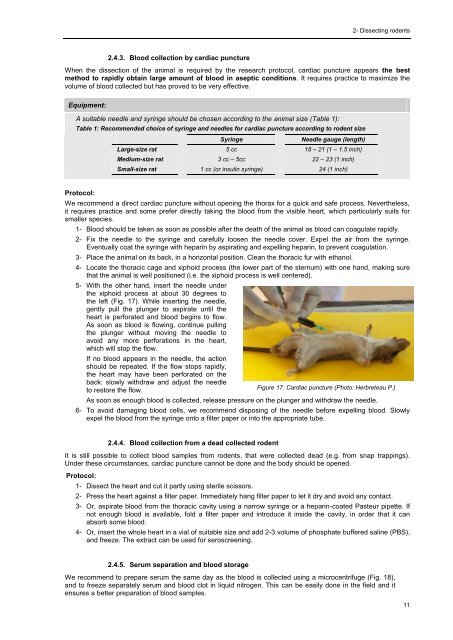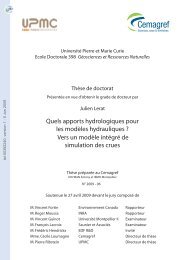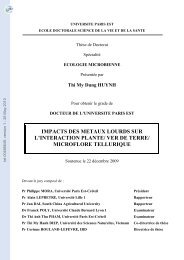Protocols for field and laboratory rodent studies - HAL
Protocols for field and laboratory rodent studies - HAL
Protocols for field and laboratory rodent studies - HAL
- No tags were found...
You also want an ePaper? Increase the reach of your titles
YUMPU automatically turns print PDFs into web optimized ePapers that Google loves.
2- Dissecting <strong>rodent</strong>s2.4.3. Blood collection by cardiac punctureWhen the dissection of the animal is required by the research protocol, cardiac puncture appears the bestmethod to rapidly obtain large amount of blood in aseptic conditions. It requires practice to maximize thevolume of blood collected but has proved to be very effective.Equipment:A suitable needle <strong>and</strong> syringe should be chosen according to the animal size (Table 1):Table 1: Recommended choice of syringe <strong>and</strong> needles <strong>for</strong> cardiac puncture according to <strong>rodent</strong> sizeSyringeNeedle gauge (length)Large-size rat 5 cc 18 – 21 (1 – 1.5 inch)Medium-size rat 3 cc – 5cc 22 – 23 (1 inch)Small-size rat 1 cc (or insulin syringe) 24 (1 inch)Protocol:We recommend a direct cardiac puncture without opening the thorax <strong>for</strong> a quick <strong>and</strong> safe process. Nevertheless,it requires practice <strong>and</strong> some prefer directly taking the blood from the visible heart, which particularly suits <strong>for</strong>smaller species.1- Blood should be taken as soon as possible after the death of the animal as blood can coagulate rapidly.2- Fix the needle to the syringe <strong>and</strong> carefully loosen the needle cover. Expel the air from the syringe.Eventually coat the syringe with heparin by aspirating <strong>and</strong> expelling heparin, to prevent coagulation.3- Place the animal on its back, in a horizontal position. Clean the thoracic fur with ethanol.4- Locate the thoracic cage <strong>and</strong> xiphoid process (the lower part of the sternum) with one h<strong>and</strong>, making surethat the animal is well positioned (i.e. the xiphoid process is well centered).5- With the other h<strong>and</strong>, insert the needle underthe xiphoid process at about 30 degrees tothe left (Fig. 17). While inserting the needle,gently pull the plunger to aspirate until theheart is per<strong>for</strong>ated <strong>and</strong> blood begins to flow.As soon as blood is flowing, continue pullingthe plunger without moving the needle toavoid any more per<strong>for</strong>ations in the heart,which will stop the flow.If no blood appears in the needle, the actionshould be repeated. If the flow stops rapidly,the heart may have been per<strong>for</strong>ated on theback: slowly withdraw <strong>and</strong> adjust the needleto restore the flow.Figure 17: Cardiac puncture (Photo: Herbreteau P.)As soon as enough blood is collected, release pressure on the plunger <strong>and</strong> withdraw the needle.6- To avoid damaging blood cells, we recommend disposing of the needle be<strong>for</strong>e expelling blood. Slowlyexpel the blood from the syringe onto a filter paper or into the appropriate tube.2.4.4. Blood collection from a dead collected <strong>rodent</strong>It is still possible to collect blood samples from <strong>rodent</strong>s, that were collected dead (e.g. from snap trappings).Under these circumstances, cardiac puncture cannot be done <strong>and</strong> the body should be opened.Protocol:1- Dissect the heart <strong>and</strong> cut it partly using sterile scissors.2- Press the heart against a filter paper. Immediately hang filter paper to let it dry <strong>and</strong> avoid any contact.3- Or, aspirate blood from the thoracic cavity using a narrow syringe or a heparin-coated Pasteur pipette. Ifnot enough blood is available, fold a filter paper <strong>and</strong> introduce it inside the cavity, in order that it canabsorb some blood.4- Or, insert the whole heart in a vial of suitable size <strong>and</strong> add 2-3 volume of phosphate buffered saline (PBS),<strong>and</strong> freeze. The extract can be used <strong>for</strong> seroscreening.2.4.5. Serum separation <strong>and</strong> blood storageWe recommend to prepare serum the same day as the blood is collected using a microcentrifuge (Fig. 18),<strong>and</strong> to freeze separately serum <strong>and</strong> blood clot in liquid nitrogen. This can be easily done in the <strong>field</strong> <strong>and</strong> itensures a better preparation of blood samples.11
















